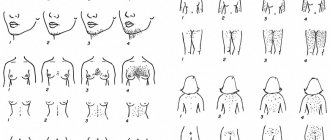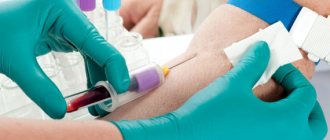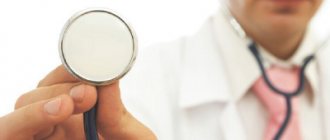Published: 07/30/2021 12:45:00 Updated: 07/30/2021
Gilbert's syndrome is the most common form of hereditary pigmentary hepatosis, characterized by impaired bilirubin metabolism due to a genetic defect in microsomal liver enzymes. Often the disease is asymptomatic for many years, but under the influence of provoking factors intermittent jaundice, dyspeptic and asthenovegetative disorders can occur.
Diagnosis requires collecting a family history, laboratory and instrumental studies. In the treatment of Gilbert's syndrome, medications of different groups are used.
Gilbert's syndrome according to the ICD corresponds to code E80.4. Men suffer from this disease four times more often than women. In general, the prevalence of pathology in European and Asian countries does not exceed 5%.
What is Gilbert's syndrome
Gilbert's syndrome (familial cholemia, constitutional hyperbilirubinemia) is a hereditary disease in which excess amounts of indirect bilirubin accumulate in the blood. This substance causes the appearance of jaundice. The syndrome itself can hardly be considered a disease, since it does not cause any subjective sensations, and jaundice may not appear at all. Histologically, the liver of people with Gilbert's syndrome is healthy, the existing changes are minor. Despite this, statistical patterns have been found in which people with Gilbert's syndrome have increased risks of certain diseases and at the same time decreased risks of others, which patients need to be aware of.
- Gilbert's syndrome is the most common hereditary liver disease.
- The probability of inheriting the disease depends on the genotype of the parents and can be 0, 25, 50 and 100%.
- The disease first makes itself felt between the ages of 12 and 30 years.
- Most often, treatment is not necessary.
- The combination of Gilbert's syndrome with other liver diseases can complicate their course.
Nutrition
The diet should be followed not only during periods of exacerbation of the disease, but also during periods of remission.
Prohibited for use:
- fatty meats, poultry and fish;
- eggs;
- hot sauces and spices;
- chocolate, pastry;
- coffee, cocoa, strong tea;
- alcohol, carbonated drinks, juices in tetra packs;
- spicy, salted, fried, smoked, canned foods;
- whole milk and high-fat dairy products (cream, sour cream).
Permitted for use:
- all types of cereals;
- vegetables and fruits in any form;
- low-fat fermented milk products;
- bread, biscuits;
- meat, poultry, fish of non-fatty varieties;
- freshly squeezed juices, fruit drinks, tea.
Symptoms of Gilbert's syndrome
The main symptom that indicates the disease is periodically occurring yellowness of the sclera, the skin of the palms and feet, the ears and the nasolabial triangle. The appearance of symptoms is probabilistic. Usually occurs against the background of physical activity, emotional stress, fasting, menstruation or an infectious disease. Often the syndrome does not produce symptoms at all, then it can only be suspected by chance - by detecting an excess of the normal value of the concentration of indirect bilirubin in the blood.
More rare symptoms include the following:
- Mild pain and feeling of heaviness in the right hypochondrium.
- Bloating.
- Nausea, loss of appetite, belching, a feeling of bitterness in the mouth are symptoms of dyspepsia.
- Stool disorders: constipation or diarrhea.
- Increased fatigue, dizziness, decreased mood - astheno-vegetative syndrome.
- Formation of pigment spots on the skin and xanthelasmas of the eyelids.
However, the listed symptoms may be the result of other diseases and they may be accidentally attributed to manifestations of Gilbert's syndrome. In addition, research¹ has shown that these symptoms are not directly related to elevated bilirubin levels.
Figure 1. Skin and eyes of a healthy person and a patient with Gilbert's syndrome. Image: solar22/Depositphotos
Reasons for the development of pathology
A chronic disease enters an exacerbation phase under the influence of certain factors. The appearance of moderate jaundice is associated with:
- with infectious viral pathologies;
- injuries, insolation, menstruation;
- errors in diet, fasting, dehydration;
- lack of sleep, excessive physical activity;
- stress, alcohol abuse, surgery.
Exacerbation of Gilbert's syndrome can be provoked by taking hormonal medications, caffeine, Paracetamol, sulfonamides, Levomycetin, anabolic steroids, etc.
Treatment of Gilbert's syndrome
In the absence of symptoms, Gilbert's syndrome does not require special treatment. But in the case of pronounced symptoms, therapeutic measures are taken depending on its severity and laboratory parameters.
During an exacerbation, attention is first paid to diet. Long breaks in eating are prohibited, drinking plenty of fluids. It is recommended to exclude from the diet:
- Fatty varieties of beef, lamb, pork, poultry (goose, duck), fish (sturgeon, catfish), as well as broths based on them.
- Coffee, cocoa, cold drinks.
- Confectionery with cream, chocolate, ice cream.
- Fresh bakery products from butter dough.
- Sour fruits and berries.
- Mushrooms, sorrel, spinach, pickled vegetables.
- Canned food, smoked products.
- Mustard, horseradish, pepper.
- Legumes.
Physical activity and sun exposure are reduced to a minimum.
In case of exacerbation of the disease, it is recommended to exclude confectionery products. Photo: wayhomestudio / freepik.com
Drug treatment
The list of medicines used is small. Prescribed:
- Phenobarbital. The drug has an inducing effect on UDP-glucuronyltransferase, the activity of which is reduced in the disease. In this way, they try to reduce the concentration of bilirubin in the blood.
- Lactulose and dioctahedral smectite. These drugs are prescribed with the aim of normalizing intestinal function and adsorption of bilirubin metabolic products.
- Ursodeoxycholic acid. This substance is part of bile and ensures its liquid state. The drug is used to prevent gallstone disease.
Additionally, vitamins (vitamins A, E, B vitamins, folic acid) and drugs for the correction of dyspeptic syndrome (aluminum hydroxide, magnesium hydroxide, domperidone, etc.) may be prescribed.
It is worth emphasizing that treatment is usually prescribed to patients with concomitant diseases or pronounced symptoms. Drug treatment is usually not required, so you should not try to take these medications on your own. The need for this can be dictated solely by the attending physician.
Features of therapy
There is no specific treatment for Gilbert's disease. The patient is registered with a gastroenterologist, and in the absence of a specialist, with a therapist. Patients are prescribed a lifelong diet with the exception of:
- sweets;
- baking;
- fatty creams;
- chocolate;
- spicy foods;
- foods with preservatives.
The diet uses:
- fruits vegetables;
- oatmeal and buckwheat porridge;
- skim cheese;
- chicken eggs - no more than one per day;
- hard cheeses, condensed milk;
- meat, fish products and poultry with minimal fat content.
Green tea, cranberry, lingonberry, and cherry juice without sugar are used as drinks. Food is taken up to 5 times a day, in small portions. Fasting or overeating is prohibited; they can cause an exacerbation of Gilbert's syndrome.
Prognosis and prevention
The prognosis for the disease is favorable. Most people do not experience any discomfort associated with Gilbert's syndrome. Any complications or long-term consequences are unlikely. Prevention measures include vaccination against hepatitis A and B and taking hepatoprotectors.
How to prevent exacerbation?
To prevent the appearance of symptoms in the future, it is enough to follow the following instructions:
- Avoid long breaks between meals.
- Follow your doctor's diet recommendations.
- Engage in physical activity regularly.
- It is rational to take medications for other diseases strictly as prescribed by the doctor, and not to self-medicate.
- Try to minimize the number of stressful situations.
- To prevent gallstone disease, take ursodeoxycholic acid once a year for 1 month.
Forecast
The disease is incurable, but if medical recommendations are followed, the pathology does not bother the person and does not reduce the quality of life. Dietary nutrition and avoidance of alcohol allow you to control the activity of the pathological process and prevent the development of complications. In addition, do not forget about regular preventive examinations.
If medical recommendations are followed, the pathology does not bother the person and does not reduce the quality of life. If you ignore the advice of a specialist and do not pay attention to the symptoms of the disease, in the near future you should expect the appearance of clinical signs of hepatitis or cholelithiasis.
Complications of Gilbert's syndrome
People with Gilbert's syndrome have an increased risk of gallstone disease, so it is advisable to periodically monitor the condition of the gallbladder in order to detect stones in time.
It is also known that the combination of hemolytic blood diseases (thalassemia, hereditary spherocytosis, sickle cell anemia) and Gilbert's syndrome is prognostically unfavorable, since in this case accelerated destruction of red blood cells occurs. Accordingly, the load on the liver increases due to the increased formation of indirect bilirubin. In such patients, hemolytic jaundice occurs more aggressively than in those who do not have the syndrome. In newborns, this combination of diseases can lead to kernikterus - malignant jaundice with brain damage.
Yellowness of the skin is the main symptom of Gilbert's syndrome. Photo: DermNet (CC BY-NC-ND 3.0 NZ)
It is also possible for jaundice and drug-induced liver damage to occur when taking certain medications. The drugs may compete with indirect bilirubin for the glucuronyl transferase binding site, causing an even greater increase in bilirubin in the blood. In addition, a number of drugs are metabolized by this enzyme, so if its activity is reduced (as in people with Gilbert's syndrome), alternative metabolic pathways come into play. Products formed in these pathways can be toxic to the liver and can cause liver damage (drug-induced hepatitis).
The increased level of bilirubin in the blood of patients with Gilbert's syndrome gives them certain benefits. Acting as an antioxidant, bilirubin can have a protective effect. Such people have a reduced incidence of coronary heart disease and the likelihood of malignant neoplasms. This applies not only to Gilbert's syndrome, but also to other conditions in which bilirubin levels are elevated.
Hyperbilirubinemia in newborns
The term hyperbilirubinemia refers to any increase in the level of bilirubin in the blood above normal. Taking into account the differences in indicators in newborns who were born at different times, hyperbilirubinemia in full-term newborns is considered when the OB level is more than 256 µmol/l, and in premature ones - more than 171 µmol/l. In newborns, direct and indirect bilirubin ; therefore, two types of hyperbilirubinemia : free (or unconjugated) and associated (synonymous with conjugated).
Hyperbilirubinemia code according to ICD-10 is P59. Any hyperbilirubinemia leads to the development of jaundice, but associated bilirubinemia is a pathological condition. Jaundice syndrome in children occurs under various conditions. Jaundice of the newborn period often requires emergency measures, since indirect bilirubin is a neurotoxic poison, especially in prematurity and in a state of hypoxia. Such children are at risk of central nervous system damage (bilirubin encephalopathy).
There are various types of jaundice in newborns, which are caused by physiological pathological reasons.
Physiological hyperbilirubinemia is a moderate transient (transient) increase in unconjugated bilirubin that occurs in the neonatal period. Hyperbilirubinemia can occur in every newborn, but 50-70% manifest as jaundice (more common in premature and immature newborns).
Physiological jaundice is characterized by:
- Appears after 36 hours of a newborn’s life.
- The peak increase in total bilirubin in a full-term baby occurs on the 3-4th day and on the 5-6th day in a premature baby.
- The child's condition does not suffer: he is active, has a good sucking reflex, normal temperature, there are periods of sleep and wakefulness, the liver and spleen are not enlarged, urine and feces are normally colored.
- A decrease in indicators by the 14th day in a full-term baby and by the 21st day in a premature baby.
Physiological jaundice has no cure, but children should receive exclusive breastfeeding, which helps to overcome jaundice faster. The child should suck often and for as long as he wants, at any time of the day and at least 8-12 times. In the vast majority of cases, jaundice in newborns is physiological, but pathological jaundice must not be missed.
Pathological jaundice has the following features:
- Appears during the first day or is detected on the feet and palms immediately after birth.
- Possible appearance on the 7th day.
- The rate of increase in OB is 85 µmol/l/day.
- The condition of the newborn is unsatisfactory, pathological symptoms are present.
- Enlarged liver and spleen.
- Discolored stool (or dark urine).
- Prolonged jaundice without a tendency to decrease - after the 14th day of life and the 21st day, respectively, in full-term and premature infants.
Pathological hyperbilirubinemia can be caused by various conditions and diseases, including:
- Caused by increased production of bilirubin (these are so-called hemolytic jaundices) in hemolytic disease of the newborn, drug hemolysis , polycythaemic syndrome , ingestion of maternal blood, hemoglobinopathies .
- Arose against the background of polycythemia .
- Developed during infectious diseases.
- Conjugation: hereditary functional bilirubinemia (Gilbert, Arias, Crigler-Nayjar syndromes), metabolic disorders, impaired bilirubin conjugation in intestinal obstruction and pyloric stenosis .
- Caused by drugs or toxins.
- Caused by immaturity of the liver (for example, late onset of conjugation, when the AB count of the indirect fraction increases).
- Mechanical jaundice due to abnormal development of the biliary tract, bile thickening syndrome, familial cholestasis , cystic fibrosis , compression of the biliary tract by various formations.
Among congenital functional bilirubinemias, Gilbert's syndrome ranks first. In newborns, this disease is similar to transient jaundice. The child has hyperbilirubinemia for a long time, but there are no other pathological changes, and there are no cases of kernicterus.
Diagnosis is made based on family history. Prescribing phenobarbital gives good results. The prognosis is favorable. Apparently healthy parents in whom the syndrome is latent may give birth to a child with this syndrome. In this regard, if there have been cases of the disease in the family, the parents need to undergo a genetic examination.
In terms of time of manifestation and severity, the first place is occupied by Crigler-Nayjar syndrome type I. This is congenital familial non-hemolytic jaundice associated with the complete absence of the enzyme glucoronyltransferase , necessary for the conjugation of bilirubin. With this syndrome, liver function is normal, there is no hemolysis and Rh conflict. This syndrome manifests itself in the first days of life with a significant increase in unconjugated bilirubin (up to 400-450 mg/l) and severe kernicterus: muscle hypertonicity , nystagmus , suppression/absence of the sucking reflex, hypotension , convulsions , lethargy .
Clinically, jaundice is noted. Unconjugated bilirubin can reach a concentration of fecal urobilinogen of no more than 100 mg/l. The use of phenobarbital has no effect. The prognosis is very poor, children rarely live beyond 1.5 years.
Crigler-Nayjar syndrome type II proceeds favorably, since the activity of the enzyme glucoronyltransferase is only reduced and liver function is not impaired. The level of unconjugated bilirubin ranges from 60-250 mg/l, especially high in the first months of life, and bilirubin encephalopathy can be observed. There was a positive response to treatment with phenobarbital.
Hemolytic disease of newborns develops when the blood of mother and child is incompatible according to the Rh factor or blood groups. The disease can occur in icteric, edematous and anemic forms. Edema is the most severe and often children are not viable. The icteric form is more favorable, but can also threaten the health of the newborn. In mild cases (indirect bilirubin level less than 60 µmol/l), conservative treatment is carried out. For moderate to severe hemolytic disease, a replacement blood transfusion may be required, and photo and infusion therapy is used before the procedure.
Jaundice in hemolytic disease is either congenital or appears on the first day of life. It has a pale yellow tint, constantly progresses and symptoms of bilirubin intoxication (CNS damage) appear. The liver and spleen are enlarged, the color of feces and urine does not change. Damage to the central nervous system develops when the level of indirect bilirubin is more than 342 µmol/l; for premature and extremely preterm infants this figure is almost 2 times lower. The depth of damage to the central nervous system also depends on the time of exposure of bilirubin to brain tissue.
To prevent hemolytic disease of newborns, women with Rh-negative blood and with group 0(I) are carefully observed, their level of Rh antibodies is determined, and, if necessary, they are delivered early. All women with Rh negative blood are given anti-D globulin . In cases of obstructive jaundice in newborns, various surgical operations are performed to remove obstacles to the outflow of bile.
Diagnosis of Gilbert's syndrome
A doctor may suspect the disease by examining the skin and palpating the abdomen, revealing characteristic jaundice and, possibly, a slightly enlarged liver.
Diagnosis of the disease must be very careful, since jaundice and increased blood bilirubin may also indicate such serious diseases as:
- Chronic persistent hepatitis.
- Cirrhosis of the liver.
- Cholelithiasis.
- Blood diseases - hemolytic anemia.
- Other hereditary liver syndromes (Crigler-Najjar, Dabin-Johnson, Rotor).
To weed out these diseases, a number of studies are carried out:
- General blood analysis.
- Blood chemistry.
- Ultrasound of the liver, gall bladder, pancreas and spleen.
- Stool examination (coprogram).
- Additionally, blood clotting parameters are examined and reactions to antibodies to various hepatitis viruses are performed.
Gilbert's syndrome requires careful diagnosis to exclude serious diseases. Photo: kliver00 / freepik.com
Is Gilbert's syndrome common?
The prevalence of this disease ranges from 4 to 16%¹ depending on the population. Thus, we can say that this is one of the most common hereditary diseases. The syndrome usually manifests itself in adolescence. It is during this period that a change in the concentration of sex hormones in the blood occurs, which affects the exchange of bilirubin (its concentration in the blood increases). It is also reliably known that symptoms occur 3-4 times more often in men than in women. This is due to the inhibitory effect of testosterone on the enzyme (UDP-glucuronyl transephrase), the activity of which is affected in patients with Gilbert's syndrome.
Pityriasis rosea in pregnant women
Pityriasis occurs more often in women than in men. It is especially dangerous when the skin disease occurs in pregnant women. If you notice any rashes, it is important to immediately visit a dermatologist and undergo treatment. It is unacceptable to risk the baby’s health and expect the plaques to disappear on their own. If the disease is not treated, then bacterial infections appear, which are much more difficult to deal with.
If a pregnant woman has not been diagnosed with pityriasis rosea, it is nevertheless important to adhere to the following recommendations:
- clothing made from cotton and linen is preferable to synthetic and woolen fabrics
- limiting heavy physical activity
- For hygienic purposes, use only warm water
- timely moisturizing of damaged skin areas
Causes of Gilbert's syndrome
The reason lies in a mutation in the gene responsible for encoding a group of enzyme proteins called glucuronyltransferases. Defective proteins do not fully perform their function - transform indirect bilirubin into direct bilirubin. For this reason, an excess amount of indirect bilirubin accumulates in the blood, which easily penetrates into the tissues, since it is a fat-soluble substance, while coloring them yellow.
How is Gilbert's syndrome inherited?
The type of transmission is autosomal recessive. This means that carriers of an incomplete mutation are healthy, but can pass on their mutant gene to their children, while those who inherited 2 mutant genes from their parents are sick. In this regard, the following conclusions can be drawn:
- The disease is transmitted to children in 100% of cases if both parents are sick.
- In 50% of cases, if one parent is sick and the other is a carrier of the mutation.
- In 25% of cases, if both parents are healthy but are carriers of the mutation.
- It is not transmitted if one of the parents is healthy and is not a carrier of the mutation.
To recognize carrier status, you can consult a geneticist.
Most frequently asked questions from patients
What causes pityriasis rosea?
There is no clear answer to this question. Research continues. Presumably, the cause may be herpes virus type 6 or 7. When immunity decreases, it becomes more active, which triggers the process of various types of rashes (plaques, vesicles, blisters). The disease can be triggered by stress, poor ecology, hormonal fluctuations, and chronic diseases.
Is pityriasis rosea contagious?
Pityriasis rosea in humans is considered non-contagious, but rare cases of the disease affecting entire families are known. Much depends on the state of the immune system and the body’s defenses, which can resist viruses, bacteria and infections.
Is it possible to sunbathe with pityriasis rosea?
One type of therapy for this dermatological disease is light therapy. Moderate exposure to ultraviolet radiation has a positive effect on the condition of the skin, stimulating its regeneration. Combustion must not be allowed. This will lead to increased itching in the area of the spots.
What is bilirubin?
Bilirubin is the main blood indicator if we are talking about Gilbert's syndrome. It's time to talk about what it is. It is a pigment that is the end product of heme metabolism. Heme is part of hemoglobin (Hb), a protein responsible for transporting oxygen in the blood. The largest amount of hemoglobin is found in red blood cells. The latter circulate in the blood for 120 days, after which they are destroyed in the spleen. Hemoglobin is broken down into heme and globin (a protein compound). The body can reuse the protein, but the heme is recycled. At the same time, it undergoes enzymatic transformation first into biliverdin (green pigment), and then into bilirubin (orange pigment). Next, the resulting bilirubin is transported in combination with albumin (blood transport protein) to the liver.
Bilirubin is a toxic fat-soluble substance in high concentrations that can accumulate in tissues, so the body disposes of it as waste. To reduce toxicity and remove this compound from the body, it must first be neutralized. For this procedure, the liver contains an enzyme that can convert fat-soluble bilirubin (indirect, unconjugated) into water-soluble (direct, conjugated). The latter is included in the composition of bile and leaves the body through the gastrointestinal tract.
Figure 2. Metabolism of bilirubin. Image: Sakurra/Depositphotos
Classification
In the case of this pathology, the doctor does not experience difficulties with classification. Gilbert's syndrome has a single form of the disease and therefore it is not accepted to officially classify it. But for convenience, the diagnosis can reflect its most striking symptom or absence of symptoms, thus indicating the clinical variant of the course. In accordance with this, we can distinguish variants of the disease:
- Dyspeptic.
- Asthenovegetative.
- Icteric.
- Latent.
The time when symptoms appear is called the period of exacerbation of the disease, and when there are no symptoms, they speak of remission or latent period.
List of sources
- Diseases of the fetus and newborn, congenital metabolic disorders / ed. R. E. Berman, V. K. Vaughan. M.: Medicine, 1991. 527 p.
- Podymova S. D. Liver diseases. M.: Medicine, 1993. - 544 p.
- Kolyubaeva S.N., Kulagina K.O., Petrova I.S., Krivoruchka A.B., Ivanova A.M. Molecular genetic diagnosis of Gilbert's syndrome using pyrosequencing. Laboratory of health care facilities. 2016; 8:4–6.
- Goncharik I.I. Gilbert's syndrome: pathogenesis and diagnosis / I.I. Goncharik, Yu.S. Kravchenko // Clinical medicine. - 2001. - No. 4. - P. 40-44.
- Kuznetsov A.S., Fomina I.G., Tarzimanova A.I., Oganesyan K.A. Differential diagnosis of benign hyperbilirubinemia // Clinical medicine. - 2001. - No. 3. - P. 8-13.









